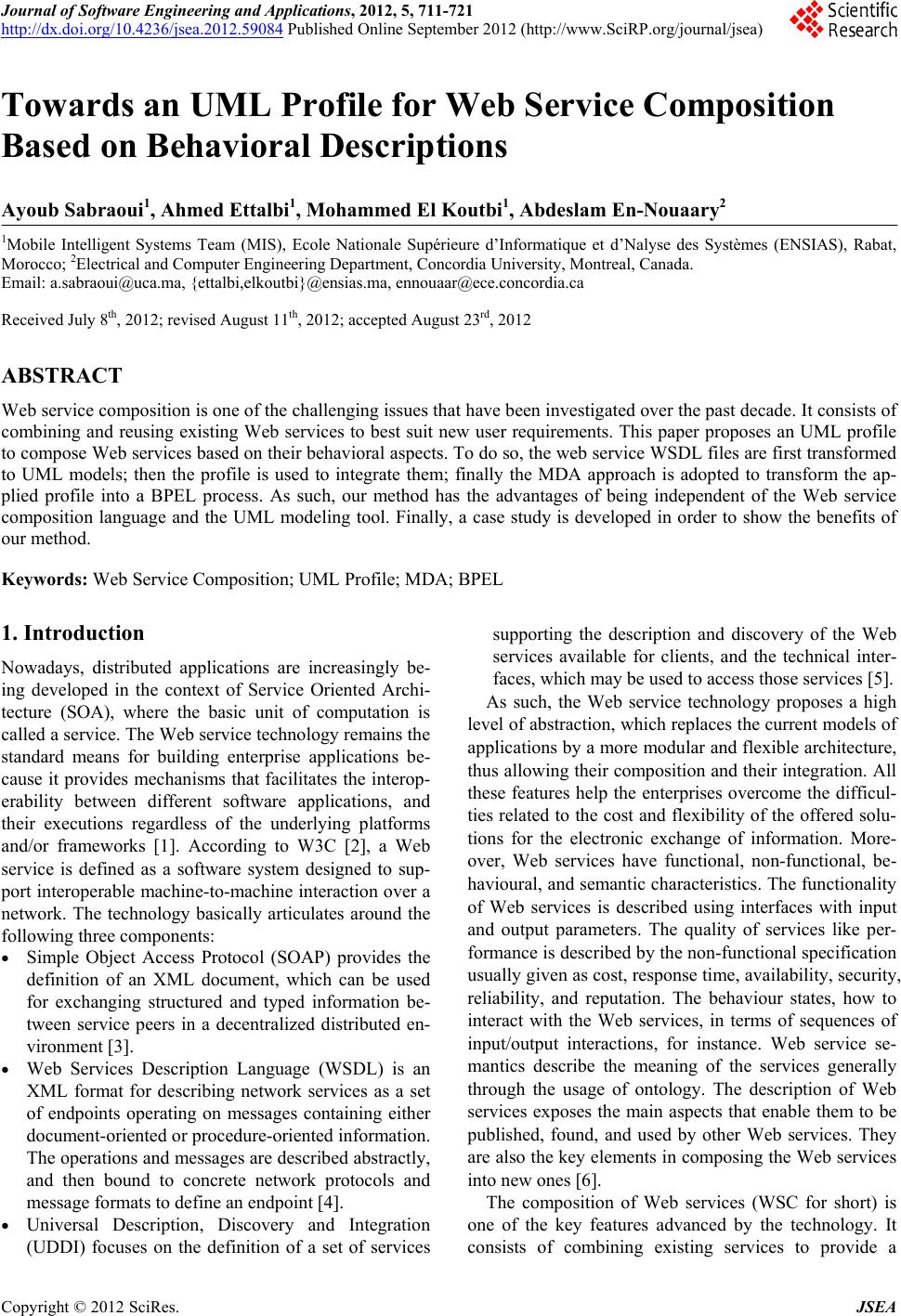 Journal of Software Engineering and Applications, 2012, 5, 711-721 http://dx.doi.org/10.4236/jsea.2012.59084 Published Online September 2012 (http://www.SciRP.org/journal/jsea) 711 Towards an UML Profile for Web Service Composition Based on Behavioral Descriptions Ayoub Sabraoui1, Ahmed Ettalbi1, Mohammed El Koutbi1, Abdeslam En-Nouaary2 1Mobile Intelligent Systems Team (MIS), Ecole Nationale Supérieure d’Informatique et d’Nalyse des Systèmes (ENSIAS), Rabat, Morocco; 2Electrical and Computer Engineering Department, Concordia University, Montreal, Canada. Email: a.sabraoui@uca.ma, {ettalbi,elkoutbi}@ensias.ma, ennouaar@ece.concordia.ca Received July 8th, 2012; revised August 11th, 2012; accepted August 23rd, 2012 ABSTRACT Web service composition is one of the challenging issues that have been investigated over the past decade. It consists of combining and reusing existing Web services to best suit new user requirements. This paper proposes an UML profile to compose Web services based on their behavioral aspects. To do so, the web service WSDL files are first transformed to UML models; then the profile is used to integrate them; finally the MDA approach is adopted to transform the ap- plied profile into a BPEL process. As such, our method has the advantages of being independent of the Web service composition language and the UML modeling tool. Finally, a case study is developed in order to show the benefits of our method. Keywords: Web Service Composition; UML Profile; MDA; BPEL 1. Introduction Nowadays, distributed applications are increasingly be- ing developed in the context of Service Oriented Archi- tecture (SOA), where the basic unit of computation is called a service. The Web service technology remains the standard means for building enterprise applications be- cause it provides mechanisms that facilitates the interop- erability between different software applications, and their executions regardless of the underlying platforms and/or frameworks [1]. According to W3C [2], a Web service is defined as a software system designed to sup- port interoperable machine-to-machine interaction over a network. The technology basically articulates around the following three components: Simple Object Access Protocol (SOAP) provides the definition of an XML document, which can be used for exchanging structured and typed information be- tween service peers in a decentralized distributed en- vironment [3]. Web Services Description Language (WSDL) is an XML format for describing network services as a set of endpoints operating on messages containing either document-oriented or procedure-oriented information. The operations and messages are described abstractly, and then bound to concrete network protocols and message formats to define an endpoint [4]. Universal Description, Discovery and Integration (UDDI) focuses on the definition of a set of services supporting the description and discovery of the Web services available for clients, and the technical inter- faces, which may be used to access those services [5]. As such, the Web service technology proposes a high level of abstraction, which replaces the current models of applications by a more modular and flexible architecture, thus allowing their composition and their integration. All these features help the enterprises overcome the difficul- ties related to the cost and flexibility of the offered solu- tions for the electronic exchange of information. More- over, Web services have functional, non-functional, be- havioural, and semantic characteristics. The functionality of Web services is described using interfaces with input and output parameters. The quality of services like per- formance is described by the non-functional specification usually given as cost, response time, availability, security, reliability, and reputation. The behaviour states, how to interact with the Web services, in terms of sequences of input/output interactions, for instance. Web service se- mantics describe the meaning of the services generally through the usage of ontology. The description of Web services exposes the main aspects that enable them to be published, found, and used by other Web services. They are also the key elements in composing the Web services into new ones [6]. The composition of Web services (WSC for short) is one of the key features advanced by the technology. It consists of combining existing services to provide a Copyright © 2012 SciRes. JSEA 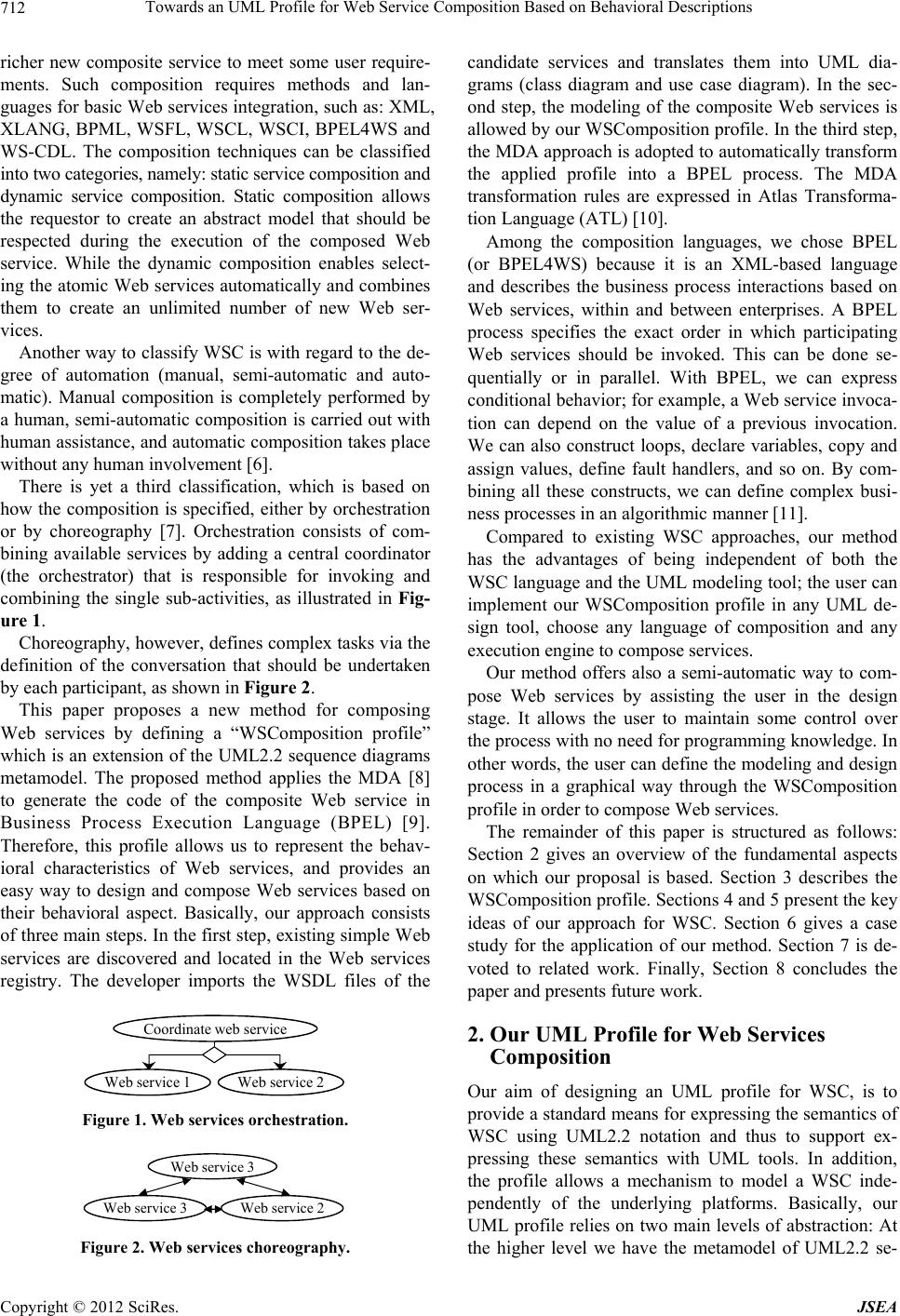 Towards an UML Profile for Web Service Composition Based on Behavioral Descriptions 712 richer new composite service to meet some user require- ments. Such composition requires methods and lan- guages for basic Web services integration, such as: XML, XLANG, BPML, WSFL, WSCL, WSCI, BPEL4WS and WS-CDL. The composition techniques can be classified into two categories, namely: static service composition and dynamic service composition. Static composition allows the requestor to create an abstract model that should be respected during the execution of the composed Web service. While the dynamic composition enables select- ing the atomic Web services automatically and combines them to create an unlimited number of new Web ser- vices. Another way to classify WSC is with regard to the de- gree of automation (manual, semi-automatic and auto- matic). Manual composition is completely performed by a human, semi-automatic composition is carried out with human assistance, and automatic composition takes place without any human involvement [6]. There is yet a third classification, which is based on how the composition is specified, either by orchestration or by choreography [7]. Orchestration consists of com- bining available services by adding a central coordinator (the orchestrator) that is responsible for invoking and combining the single sub-activities, as illustrated in Fig- ure 1. Choreography, however, defines complex tasks via the definition of the conversation that should be undertaken by each participant, as shown in Figure 2. This paper proposes a new method for composing Web services by defining a “WSComposition profile” which is an extension of the UML2.2 sequence diagrams metamodel. The proposed method applies the MDA [8] to generate the code of the composite Web service in Business Process Execution Language (BPEL) [9]. Therefore, this profile allows us to represent the behav- ioral characteristics of Web services, and provides an easy way to design and compose Web services based on their behavioral aspect. Basically, our approach consists of three main steps. In the first step, existing simple Web services are discovered and located in the Web services registry. The developer imports the WSDL files of the Web service 1Web service 2 Coordinate web service Figure 1. Web services orchestration. Web service 3Web service 2 Web service 3 Figure 2. Web services choreography. candidate services and translates them into UML dia- grams (class diagram and use case diagram). In the sec- ond step, the modeling of the composite Web services is allowed by our WSComposition profile. In the third step, the MDA approach is adopted to automatically transform the applied profile into a BPEL process. The MDA transformation rules are expressed in Atlas Transforma- tion Language (ATL) [10]. Among the composition languages, we chose BPEL (or BPEL4WS) because it is an XML-based language and describes the business process interactions based on Web services, within and between enterprises. A BPEL process specifies the exact order in which participating Web services should be invoked. This can be done se- quentially or in parallel. With BPEL, we can express conditional behavior; for example, a Web service invoca- tion can depend on the value of a previous invocation. We can also construct loops, declare variables, copy and assign values, define fault handlers, and so on. By com- bining all these constructs, we can define complex busi- ness processes in an algorithmic manner [11]. Compared to existing WSC approaches, our method has the advantages of being independent of both the WSC language and the UML modeling tool; the user can implement our WSComposition profile in any UML de- sign tool, choose any language of composition and any execution engine to compose services. Our method offers also a semi-automatic way to com- pose Web services by assisting the user in the design stage. It allows the user to maintain some control over the process with no need for programming knowledge. In other words, the user can define the modeling and design process in a graphical way through the WSComposition profile in order to compose Web services. The remainder of this paper is structured as follows: Section 2 gives an overview of the fundamental aspects on which our proposal is based. Section 3 describes the WSComposition profile. Sections 4 and 5 present the key ideas of our approach for WSC. Section 6 gives a case study for the application of our method. Section 7 is de- voted to related work. Finally, Section 8 concludes the paper and presents future work. 2. Our UML Profile for Web Services Composition Our aim of designing an UML profile for WSC, is to provide a standard means for expressing the semantics of WSC using UML2.2 notation and thus to support ex- pressing these semantics with UML tools. In addition, the profile allows a mechanism to model a WSC inde- pendently of the underlying platforms. Basically, our UML profile relies on two main levels of abstraction: At the higher level we have the metamodel of UML2.2 se- Copyright © 2012 SciRes. JSEA  Towards an UML Profile for Web Service Composition Based on Behavioral Descriptions Copyright © 2012 SciRes. JSEA 713 by two stereotypes: “Actor” and “WebService”. The lat- ter stereotype is specialized by the “CordinateWS” one, which represents the business process. quence diagrams that defines the basic entities of the model, whereas at the second level, we have the WS- Composition UML profile which adapts the previous metamodel for WSC. On the other hand and in order to manage the mes- sages exchanged between client and services or those invoked from other services, we extend the Message class in three stereotypes: Receive, Reply and Invoke. 2.1. The Metamodel of UML2.2 Sequence Diagrams “Receive” element allows business process to wait for a matching message to arrive. This stereotype has a filled arrow head. Here, we present the sequence diagrams metamodel which constitutes a type of the interaction package of UML2.2 metamodel. To define our profile we use the Lifeline, Message and Combined Fragment classes as defined in OMG UML2.2 [12]: A lifeline is a Named Element that represents an individual participant in the Interaction. While Parts and Structural Features may have multiplicity greater than 1, Lifelines represent only one interacting entity. Message, however, is a Named Element that defines one specific kind of communication between lifelines of an interaction. The message specifies not only the kind of communication, but also the sender and the receiver. Sender and receiver are normally two occurrence specifications (points at the ends of mes- sages). Finally, combined fragment is an interaction fragment which defines a combination (expression) of interaction fragments. A combined fragment is defined by an interaction operator and corresponding interaction operands. Through the use of combined fragments the user will be able to describe a number of traces in a compact and concise manner. “Reply” element allows the business process to send a message in reply to a message that was received by “re- ceive” stereotype. It has a dashed line with open arrow head. “Invoke” element allows the business process to in- voke a one-way or request-response operation on a port- type offered by a partner. In the request-response case, the invoke activity completes when the response is re- ceived. This stereotype has an open arrow head. Finally and for managing the workflow of the business process, we extend the Combined Fragment class in the “Control Flow” stereotype, which contains an enumera- tion designating the different kinds of control flow ele- ments, like sequential, parallel, alternative and iterative activities. Beside the aforementioned steretypes, our UML pro- file uses the enumerated type Activity Element Kind de- fines a set of available activity types. They are presented as follows: 2.2. WSComposition UML Profile Sequential activity: defines a list of activities to be per- formed sequentially in lexical order. This section presents the WSComposition UML Profile which is a group of extensions of UML2.2 sequence dia- grams metamodel. We present some elements that we extend and specialize to define our Profile, as shown in Figure 3. On the one hand, we extend the Lifeline class Parallel activity: specifies one or more activities to be performed concurrently. Alternative activity: is used to select one activity for execution from a set of choices. 1..* {required} « stereotype » WebService « stereotype » Coordinat eWS « stereotype » Actor + interaction 1 + lifeline * CombinedFragment ActivityElement :ActivityElementKind Sequential Parallel Alternative Iterati ve <<enumeration>> ActivityElementKind Interaction InteractionOperand Condition 0..1 « stereotype » Reply « stereotype » Receive « stereotype » Invoke 0..1 * 0..1 * 1 * « stereotype » ControlFlow Message Lifeline <<profile>> WSComposition profile Figure 3. Excerpt of the WSComposition UML profile. 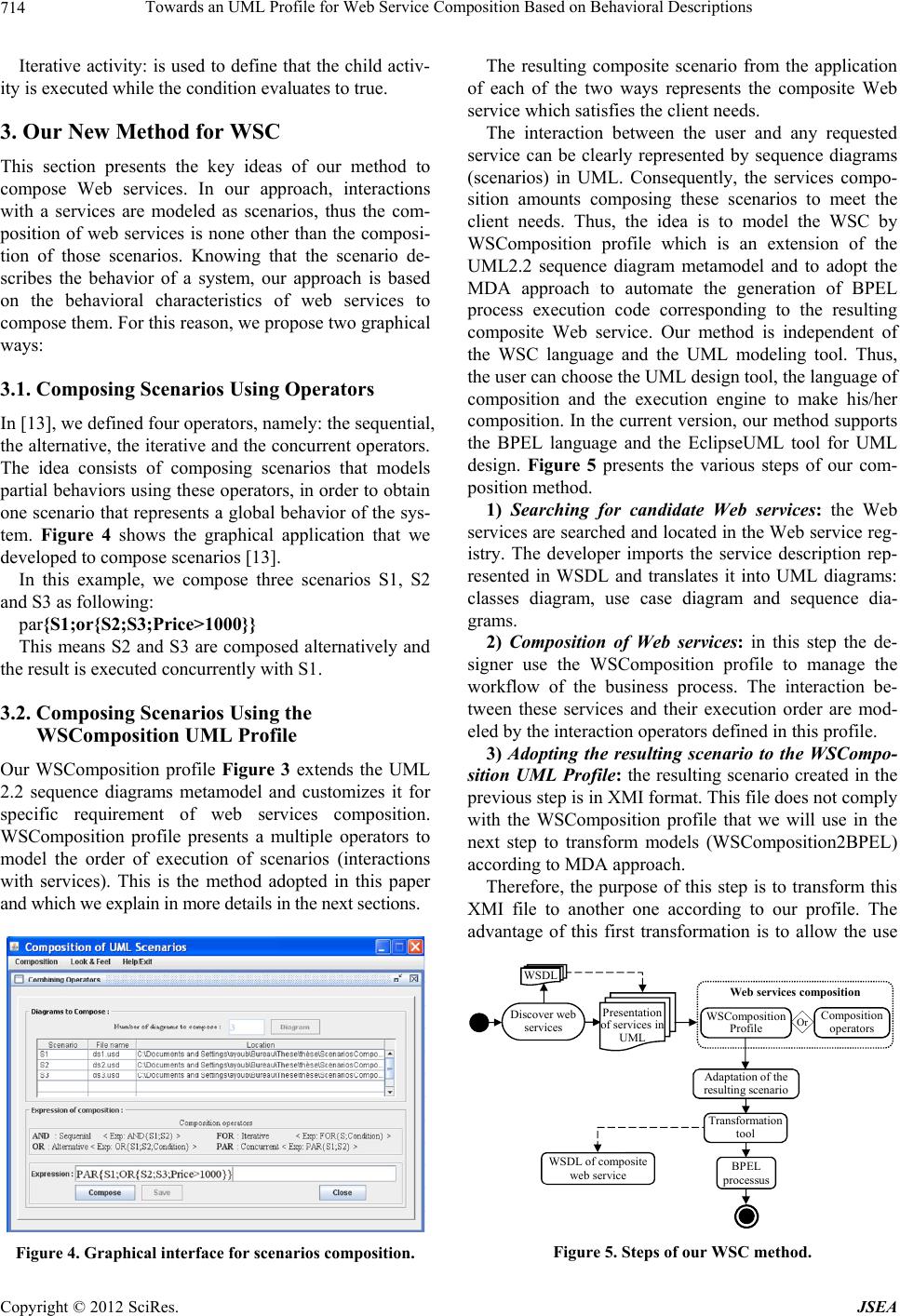 Towards an UML Profile for Web Service Composition Based on Behavioral Descriptions 714 Iterative activity: is used to define that the child activ- ity is executed while the condition evaluates to true. 3. Our New Method for WSC This section presents the key ideas of our method to compose Web services. In our approach, interactions with a services are modeled as scenarios, thus the com- position of web services is none other than the composi- tion of those scenarios. Knowing that the scenario de- scribes the behavior of a system, our approach is based on the behavioral characteristics of web services to compose them. For this reason, we propose two graphical ways: 3.1. Composing Scenarios Using Operators In [13], we defined four operators, namely: the sequential, the alternative, the iterative and the concurrent operators. The idea consists of composing scenarios that models partial behaviors using these operators, in order to obtain one scenario that represents a global behavior of the sys- tem. Figure 4 shows the graphical application that we developed to compose scenarios [13]. In this example, we compose three scenarios S1, S2 and S3 as following: par{S1;or{S2;S3;Price>1000}} This means S2 and S3 are composed alternatively and the result is executed concurrently with S1. 3.2. Composing Scenarios Using the WSComposition UML Profile Our WSComposition profile Figure 3 extends the UML 2.2 sequence diagrams metamodel and customizes it for specific requirement of web services composition. WSComposition profile presents a multiple operators to model the order of execution of scenarios (interactions with services). This is the method adopted in this paper and which we explain in more details in the next sections. Figure 4. Graphical interface for scenarios composition. The resulting composite scenario from the application of each of the two ways represents the composite Web service which satisfies the client needs. The interaction between the user and any requested service can be clearly represented by sequence diagrams (scenarios) in UML. Consequently, the services compo- sition amounts composing these scenarios to meet the client needs. Thus, the idea is to model the WSC by WSComposition profile which is an extension of the UML2.2 sequence diagram metamodel and to adopt the MDA approach to automate the generation of BPEL process execution code corresponding to the resulting composite Web service. Our method is independent of the WSC language and the UML modeling tool. Thus, the user can choose the UML design tool, the language of composition and the execution engine to make his/her composition. In the current version, our method supports the BPEL language and the EclipseUML tool for UML design. Figure 5 presents the various steps of our com- position method. 1) Searching for candidate Web services: the Web services are searched and located in the Web service reg- istry. The developer imports the service description rep- resented in WSDL and translates it into UML diagrams: classes diagram, use case diagram and sequence dia- grams. 2) Composition of Web services: in this step the de- signer use the WSComposition profile to manage the workflow of the business process. The interaction be- tween these services and their execution order are mod- eled by the interaction operators defined in this profile. 3) Adopting the resulting scenario to the WSCompo- sition UML Profile: the resulting scenario created in the previous step is in XMI format. This file does not comply with the WSComposition profile that we will use in the next step to transform models (WSComposition2BPEL) according to MDA approach. Therefore, the purpose of this step is to transform this XMI file to another one according to our profile. The advantage of this first transformation is to allow the use Presentation of services in UML WSDL of composite web service Discover web services WSDL Web services composition Composition operators Or BPEL processus Transformation tool Adaptation of the resulting scenario WSComposition Profile Figure 5. Steps of our WSC method. Copyright © 2012 SciRes. JSEA 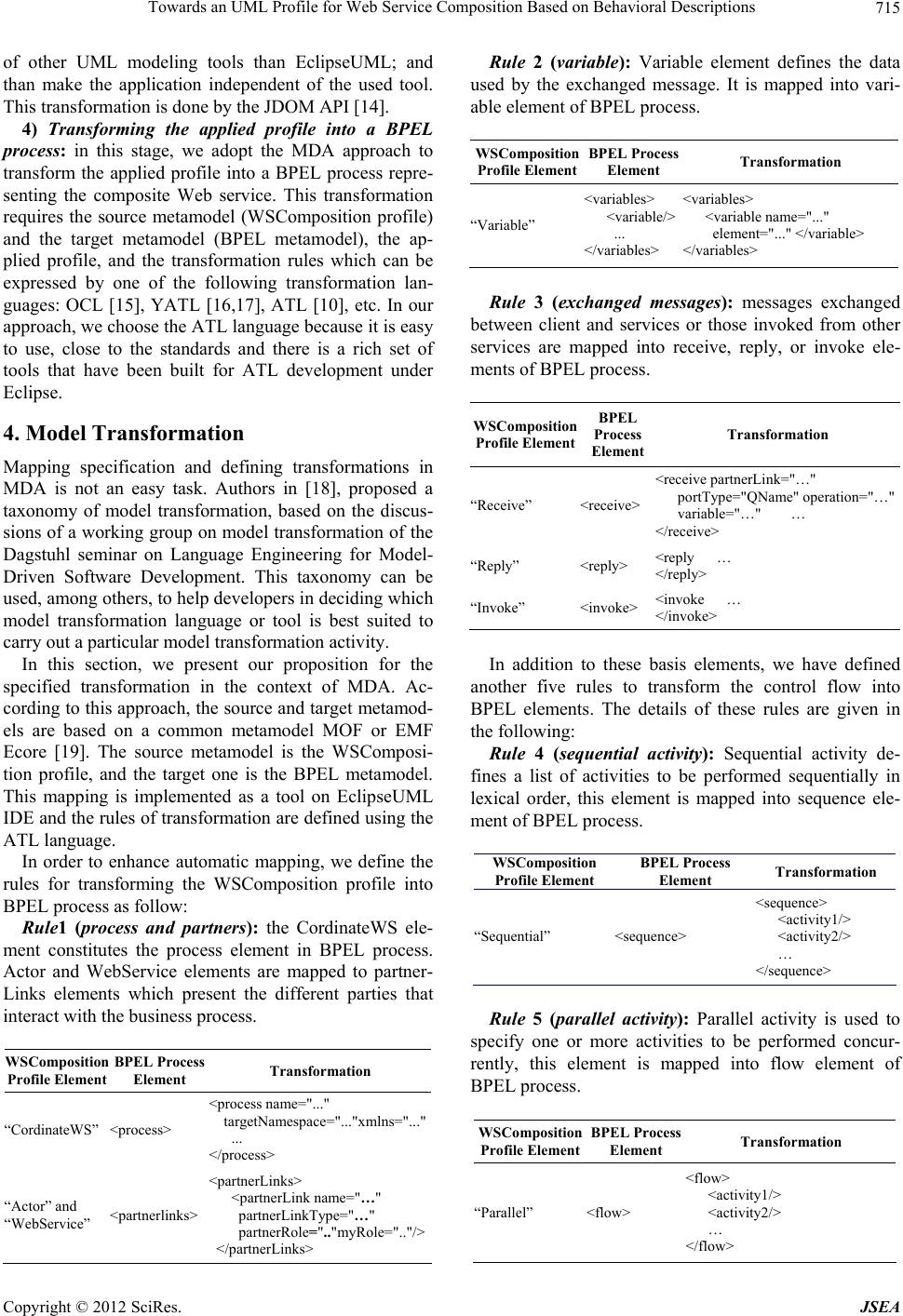 Towards an UML Profile for Web Service Composition Based on Behavioral Descriptions 715 of other UML modeling tools than EclipseUML; and than make the application independent of the used tool. This transformation is done by the JDOM API [14]. 4) Transforming the applied profile into a BPEL process: in this stage, we adopt the MDA approach to transform the applied profile into a BPEL process repre- senting the composite Web service. This transformation requires the source metamodel (WSComposition profile) and the target metamodel (BPEL metamodel), the ap- plied profile, and the transformation rules which can be expressed by one of the following transformation lan- guages: OCL [15], YATL [16,17], ATL [10], etc. In our approach, we choose the ATL language because it is easy to use, close to the standards and there is a rich set of tools that have been built for ATL development under Eclipse. 4. Model Transformation Mapping specification and defining transformations in MDA is not an easy task. Authors in [18], proposed a taxonomy of model transformation, based on the discus- sions of a working group on model transformation of the Dagstuhl seminar on Language Engineering for Model- Driven Software Development. This taxonomy can be used, among others, to help developers in deciding which model transformation language or tool is best suited to carry out a particular model transformation activity. In this section, we present our proposition for the specified transformation in the context of MDA. Ac- cording to this approach, the source and target metamod- els are based on a common metamodel MOF or EMF Ecore [19]. The source metamodel is the WSComposi- tion profile, and the target one is the BPEL metamodel. This mapping is implemented as a tool on EclipseUML IDE and the rules of transformation are defined using the ATL language. In order to enhance automatic mapping, we define the rules for transforming the WSComposition profile into BPEL process as follow: Rule1 (process and partners): the CordinateWS ele- ment constitutes the process element in BPEL process. Actor and WebService elements are mapped to partner- Links elements which present the different parties that interact with the business process. WSComposition Profile Element BPEL Process Element Transformation “CordinateWS” <process> <process name="..." targetNamespace="..."xmlns="..." ... </process> “Actor” and “WebService” <partnerlinks> <partnerLinks> <partnerLink name="…" partnerLinkType="…" partnerRole=".."myRole=".."/> </partnerLinks> Rule 2 (variable): Variable element defines the data used by the exchanged message. It is mapped into vari- able element of BPEL process. WSComposition Profile Element BPEL Process Element Transformation “Variable” <variables> <variable/> ... </variables> <variables> <variable name="..." element="..." </variable> </variables> Rule 3 (exchanged messages): messages exchanged between client and services or those invoked from other services are mapped into receive, reply, or invoke ele- ments of BPEL process. WSComposition Profile Element BPEL Process Element Transformation “Receive” <receive> <receive partnerLink="…" portType="QName" operation="…" variable="…" … </receive> “Reply” <reply> <reply … </reply> “Invoke” <invoke> <invoke … </invoke> In addition to these basis elements, we have defined another five rules to transform the control flow into BPEL elements. The details of these rules are given in the following: Rule 4 (sequential activity): Sequential activity de- fines a list of activities to be performed sequentially in lexical order, this element is mapped into sequence ele- ment of BPEL process. WSComposition Profile Element BPEL Process Element Transformation “Sequential” <sequence> <sequence> <activity1/> <activity2/> … </sequence> Rule 5 (parallel activity): Parallel activity is used to specify one or more activities to be performed concur- rently, this element is mapped into flow element of BPEL process. WSComposition Profile Element BPEL Process Element Transformation “Parallel” <flow> <flow> <activity1/> <activity2/> … </flow> Copyright © 2012 SciRes. JSEA 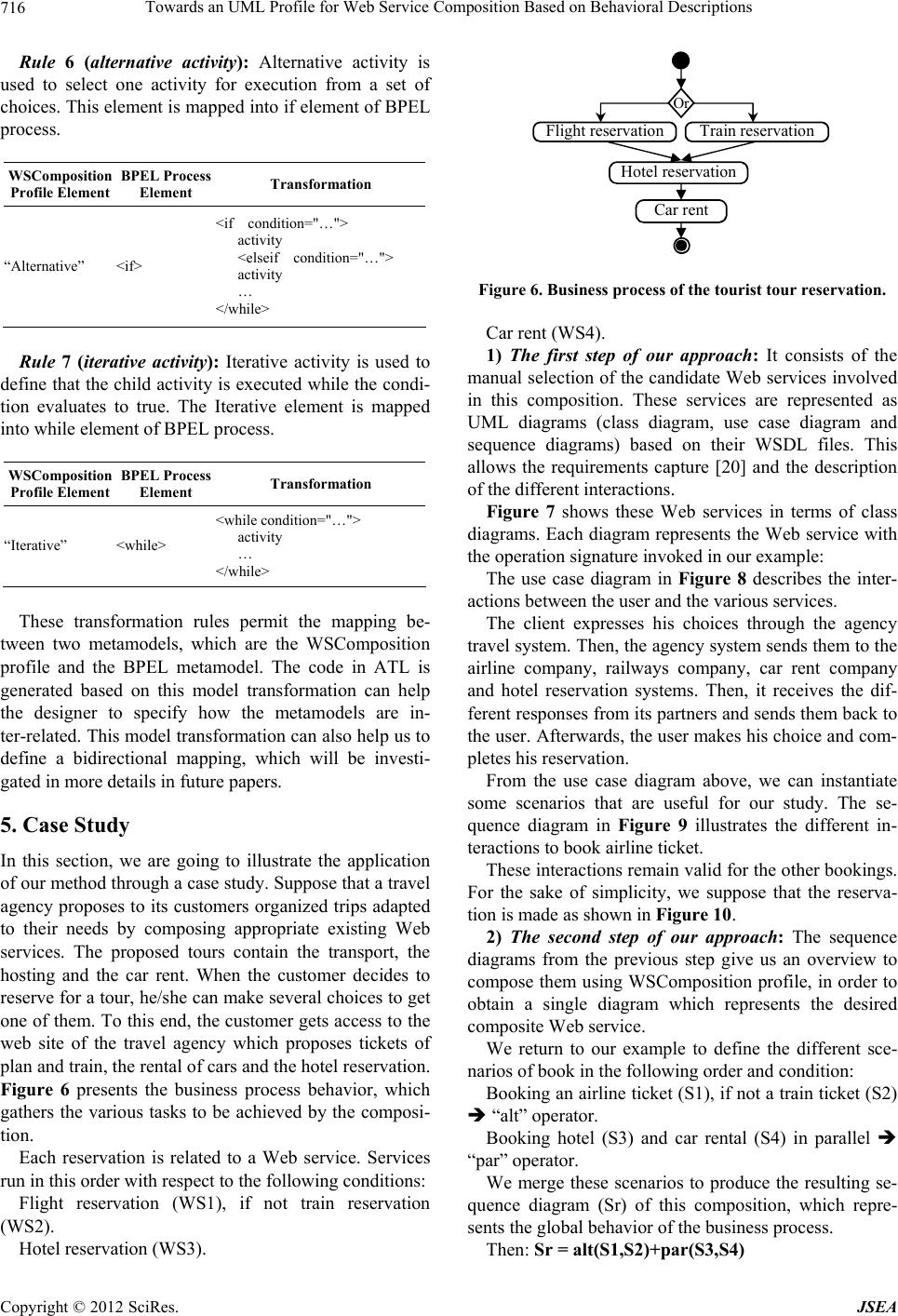 Towards an UML Profile for Web Service Composition Based on Behavioral Descriptions 716 Rule 6 (alternative activity): Alternative activity is used to select one activity for execution from a set of choices. This element is mapped into if element of BPEL process. WSComposition Profile Element BPEL Process Element Transformation “Alternative” <if> <if condition="…"> activity <elseif condition="…"> activity … </while> Rule 7 (iterative activity): Iterative activity is used to define that the child activity is executed while the condi- tion evaluates to true. The Iterative element is mapped into while element of BPEL process. WSComposition Profile Element BPEL Process Element Transformation “Iterative” <while> <while condition="…"> activity … </while> These transformation rules permit the mapping be- tween two metamodels, which are the WSComposition profile and the BPEL metamodel. The code in ATL is generated based on this model transformation can help the designer to specify how the metamodels are in- ter-related. This model transformation can also help us to define a bidirectional mapping, which will be investi- gated in more details in future papers. 5. Case Study In this section, we are going to illustrate the application of our method through a case study. Suppose that a travel agency proposes to its customers organized trips adapted to their needs by composing appropriate existing Web services. The proposed tours contain the transport, the hosting and the car rent. When the customer decides to reserve for a tour, he/she can make several choices to get one of them. To this end, the customer gets access to the web site of the travel agency which proposes tickets of plan and train, the rental of cars and the hotel reservation. Figure 6 presents the business process behavior, which gathers the various tasks to be achieved by the composi- tion. Each reservation is related to a Web service. Services run in this order with respect to the following conditions: Flight reservation (WS1), if not train reservation (WS2). Hotel reservation (WS3). Or Flight reservationTrain reservation Hotel reservation Car rent Figure 6. Business process of the tourist tour reservation. Car rent (WS4). 1) The first step of our approach: It consists of the manual selection of the candidate Web services involved in this composition. These services are represented as UML diagrams (class diagram, use case diagram and sequence diagrams) based on their WSDL files. This allows the requirements capture [20] and the description of the different interactions. Figure 7 shows these Web services in terms of class diagrams. Each diagram represents the Web service with the operation signature invoked in our example: The use case diagram in Figure 8 describes the inter- actions between the user and the various services. The client expresses his choices through the agency travel system. Then, the agency system sends them to the airline company, railways company, car rent company and hotel reservation systems. Then, it receives the dif- ferent responses from its partners and sends them back to the user. Afterwards, the user makes his choice and com- pletes his reservation. From the use case diagram above, we can instantiate some scenarios that are useful for our study. The se- quence diagram in Figure 9 illustrates the different in- teractions to book airline ticket. These interactions remain valid for the other bookings. For the sake of simplicity, we suppose that the reserva- tion is made as shown in Figure 10. 2) The second step of our approach: The sequence diagrams from the previous step give us an overview to compose them using WSComposition profile, in order to obtain a single diagram which represents the desired composite Web service. We return to our example to define the different sce- narios of book in the following order and condition: Booking an airline ticket (S1), if not a train ticket (S2) “alt” operator. Booking hotel (S3) and car rental (S4) in parallel “par” operator. We merge these scenarios to produce the resulting se- quence diagram (Sr) of this composition, which repre- sents the global behavior of the business process. Then: Sr = alt(S1,S2)+par(S3,S4) Copyright © 2012 SciRes. JSEA 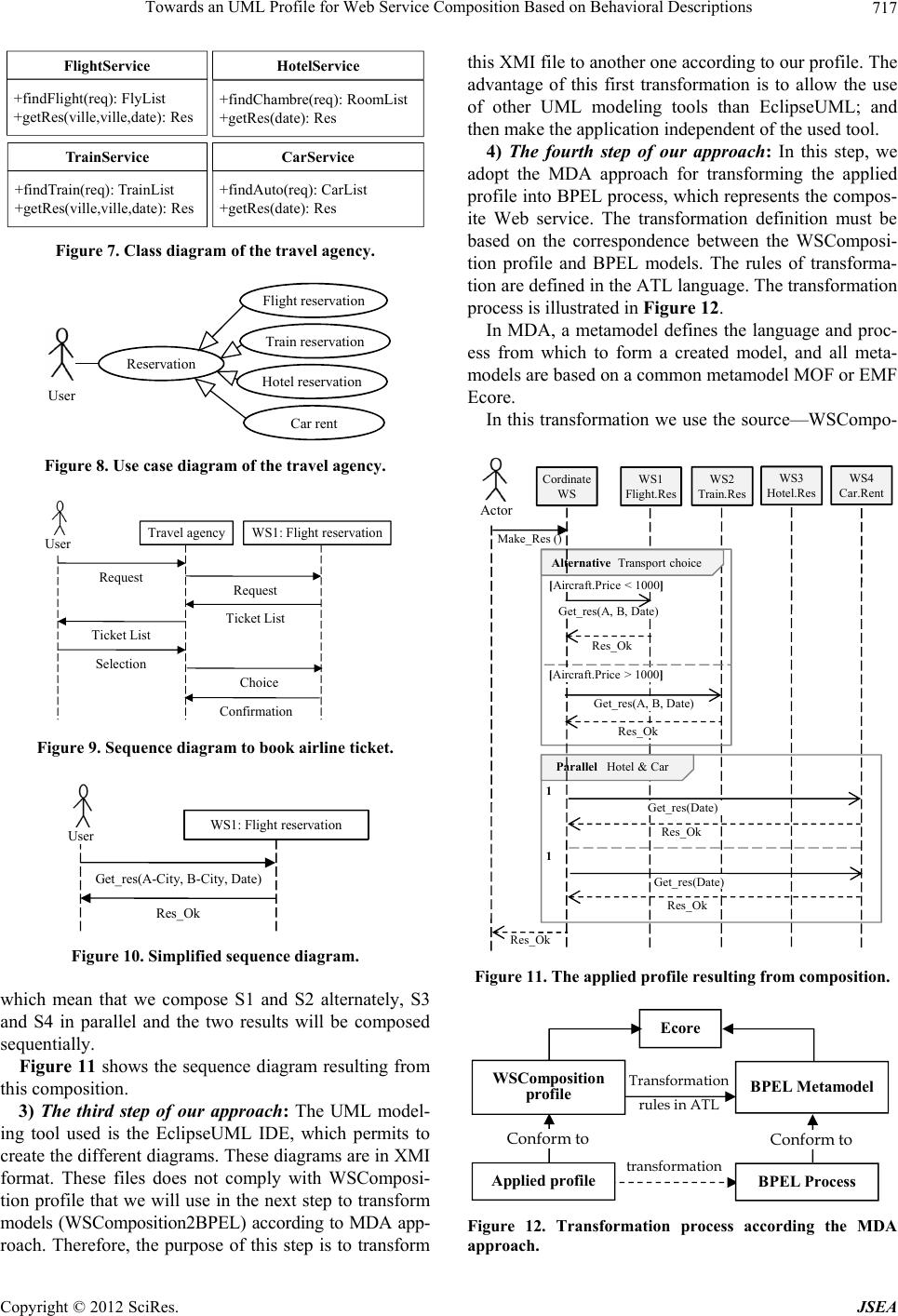 Towards an UML Profile for Web Service Composition Based on Behavioral Descriptions 717 FlightService +findFlight(req): FlyList +getRes(ville,ville,date): Res CarServ ice +findAuto(req): CarList +getRes(date): Res HotelService +findChambre(req): RoomList +getRes(date): Res TrainService +findTrain(req): TrainList +getRes(ville,ville,date): Res Figure 7. Class diagram of the travel agency. User Reservation Flight reservation Train reservation Hotel reservation Car rent Figure 8. Use case diagram of the travel agency. WS1: Flight reservationTravel agency Request Request Ticket List Ticket List Selection Choice Confirmation User Figure 9. Sequence diagram to book airline ticket. WS1: Flight reservation Get_res(A-City, B-City, Date) User Res_Ok Figure 10. Simplified sequence diagram. which mean that we compose S1 and S2 alternately, S3 and S4 in parallel and the two results will be composed sequentially. Figure 11 shows the sequence diagram resulting from this composition. 3) The third step of our approach: The UML model- ing tool used is the EclipseUML IDE, which permits to create the different diagrams. These diagrams are in XMI format. These files does not comply with WSComposi- tion profile that we will use in the next step to transform models (WSComposition2BPEL) according to MDA app- roach. Therefore, the purpose of this step is to transform this XMI file to another one according to our profile. The advantage of this first transformation is to allow the use of other UML modeling tools than EclipseUML; and then make the application independent of the used tool. 4) The fourth step of our approach: In this step, we adopt the MDA approach for transforming the applied profile into BPEL process, which represents the compos- ite Web service. The transformation definition must be based on the correspondence between the WSComposi- tion profile and BPEL models. The rules of transforma- tion are defined in the ATL language. The transformation process is illustrated in Figure 12. In MDA, a metamodel defines the language and proc- ess from which to form a created model, and all meta- models are based on a common metamodel MOF or EMF Ecore. In this transformation we use the source—WSCompo- WS1 Flight.Res Act or Res_Ok WS2 Train.Res WS3 Hotel. Re s WS4 Car.Rent Get_res(A, B, Date) Res_Ok Alternative Transport choice Get_res(Date) Res_Ok Get_res(Date) Res_Ok ParallelHotel& Car 1 1 Cordinate WS Make_Res () Res_Ok [Aircraft.Price > 1000] [Aircraft.Price < 1000] Get_res(A, B, Date) Figure 11. The applied profile resulting from composition. Ecore transformation Conform to Transformation rules in ATL BPEL Process Conform to BPEL Metamodel Applied profile WSComposition profi le Figure 12. Transformation process according the MDA approach. Copyright © 2012 SciRes. JSEA 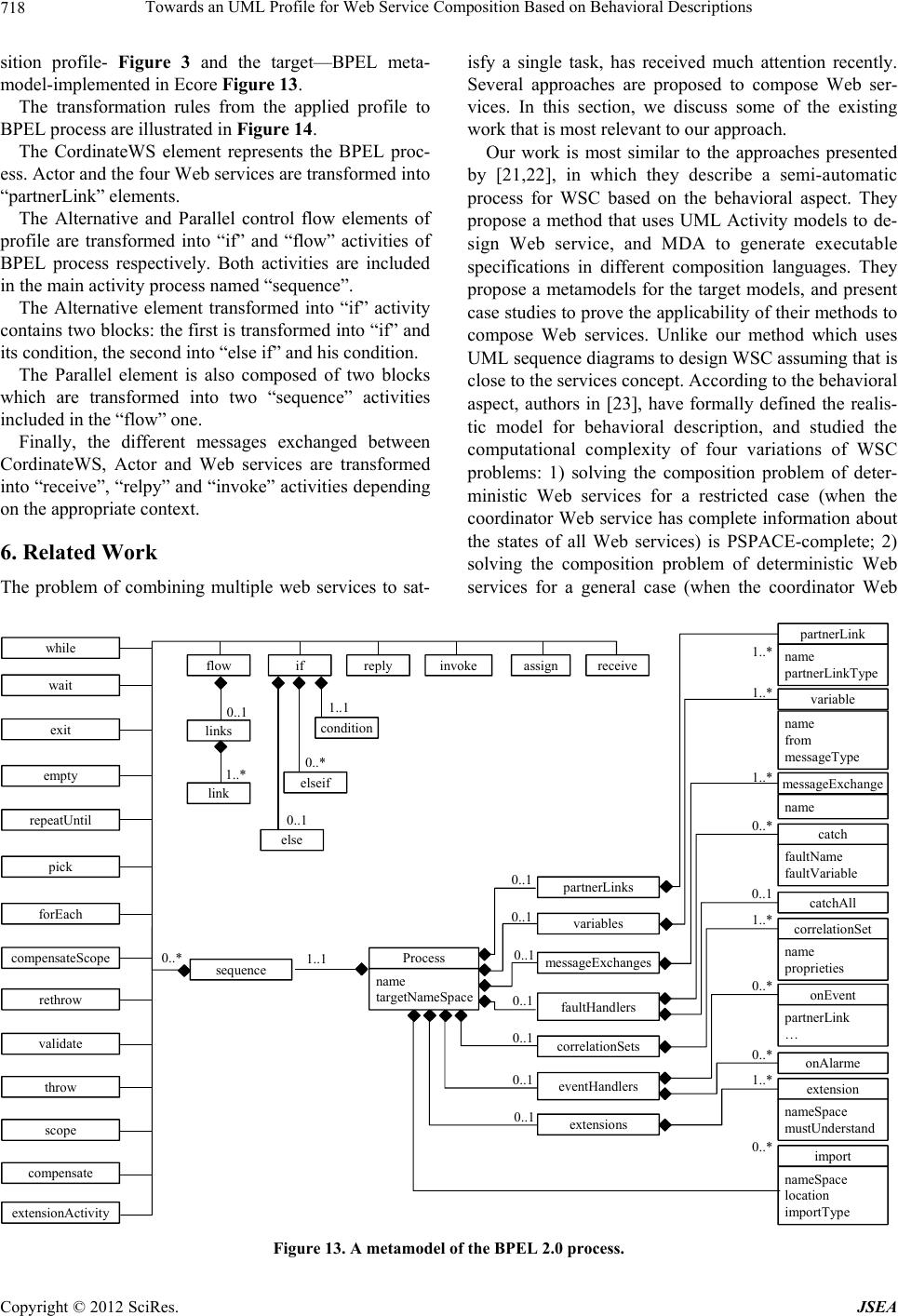 Towards an UML Profile for Web Service Composition Based on Behavioral Descriptions Copyright © 2012 SciRes. JSEA 718 sition profile- Figure 3 and the target—BPEL meta- model-implemented in Ecore Figure 13. isfy a single task, has received much attention recently. Several approaches are proposed to compose Web ser- vices. In this section, we discuss some of the existing work that is most relevant to our approach. The transformation rules from the applied profile to BPEL process are illustrated in Figure 14. The CordinateWS element represents the BPEL proc- ess. Actor and the four Web services are transformed into “partnerLink” elements. Our work is most similar to the approaches presented by [21,22], in which they describe a semi-automatic process for WSC based on the behavioral aspect. They propose a method that uses UML Activity models to de- sign Web service, and MDA to generate executable specifications in different composition languages. They propose a metamodels for the target models, and present case studies to prove the applicability of their methods to compose Web services. Unlike our method which uses UML sequence diagrams to design WSC assuming that is close to the services concept. According to the behavioral aspect, authors in [23], have formally defined the realis- tic model for behavioral description, and studied the computational complexity of four variations of WSC problems: 1) solving the composition problem of deter- ministic Web services for a restricted case (when the coordinator Web service has complete information about the states of all Web services) is PSPACE-complete; 2) solving the composition problem of deterministic Web services for a general case (when the coordinator Web The Alternative and Parallel control flow elements of profile are transformed into “if” and “flow” activities of BPEL process respectively. Both activities are included in the main activity process named “sequence”. The Alternative element transformed into “if” activity contains two blocks: the first is transformed into “if” and its condition, the second into “else if” and his condition. The Parallel element is also composed of two blocks which are transformed into two “sequence” activities included in the “flow” one. Finally, the different messages exchanged between CordinateWS, Actor and Web services are transformed into “receive”, “relpy” and “invoke” activities depending on the appropriate context. 6. Related Work The problem of combining multiple web services to sat- 1..* partnerLink name partner LinkT ype variable name from messageType messageExchange name catch faultName faultVariable catchAll correlationSet name proprieties onEvent partnerLink … onAlarme extension nameSpace mustU nd e rs ta nd import nameSpace location importType name targetNameSpace partnerLinks variable s messageExchanges faultHandlers correlationSets eventHandlers extensions Process sequence exit 1..* 1..* 0..* 0..1 1..* 0..* 0..* 0..* 1..* 0..1 0..1 0..1 0..1 0..1 0..1 0..1 1..1 wait invoke empty reply repeatUntil pick forEach compensateScope assign rethrow validate throw scope while extensionActivity ifflow links link 0..1 1..* condition elseif else 1..1 0..* 0..1 compensate receive 0..* Figure 13. A metamodel of the BPEL 2.0 process. 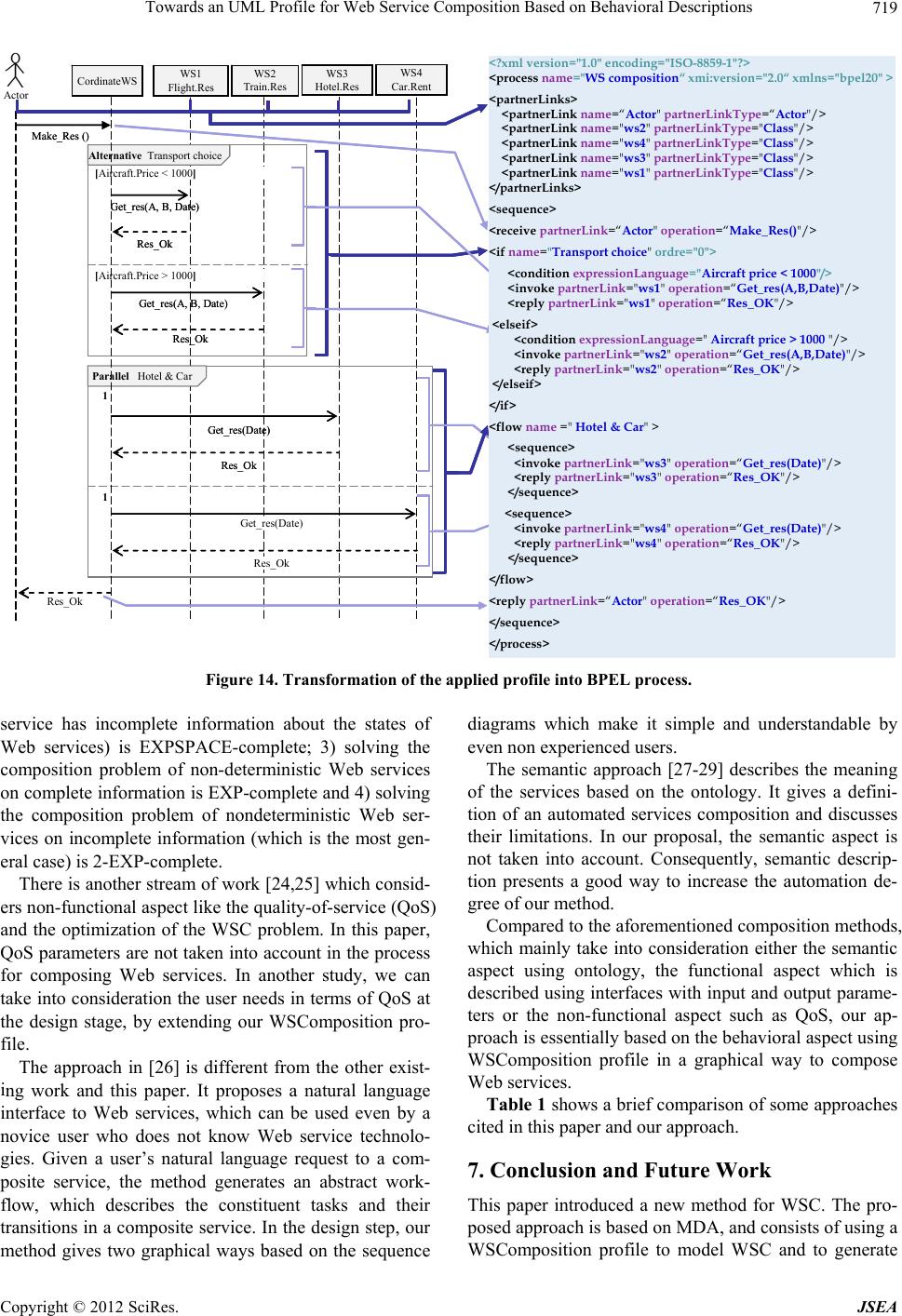 Towards an UML Profile for Web Service Composition Based on Behavioral Descriptions 719 WS1 Flight.Res Get_res(A, B, Date) Actor Res_Ok WS2 Train.Res WS3 Hotel.Res WS4 Car.Rent Get_res(A, B, Date) Res_Ok Alternative Transport choice [Aircraft.Price < 1000] [Aircraft.Price > 1000] Get_res(Date) Res_Ok Get_res(Date) Res_Ok ParallelHotel & Car 1 1 Cord inateWS Make_Res () Res_Ok <?xml version="1.0" encoding="ISO-8859-1"?> <process na me=" WS composition“ xmi:version="2.0“ xmlns="bpel20" > <partnerLinks> <partnerLink name =“ Actor" partnerLinkType=“Actor"/> <partnerLink name =" ws2" partne rLinkType="Class"/> <partnerLink name =" ws4" partne rLinkType="Class"/> <partnerLink name =" ws3" partne rLinkType="Class"/> <partnerLink nam e =" ws1" partne rLinkType="Class"/> </partnerLinks> <sequence > <receive partnerLink=“Actor" operation=“Make_Res()"/> <if name="Transport choice" ord re="0 "> <condition ex pression La ngu a ge=" Aircraft price < 1000"/> <invoke partnerLink="ws 1 " operation =“Ge t_res(A ,B,Da te)"/> <reply partnerLink=" ws1" opera tion=“Res_OK"/> <els eif > <condition expressionLanguage=" Aircraft price > 1000 "/> <invoke partnerLink="ws2 " operation=“Get_res(A, B,Da te)"/> <reply pa r tn er L ink ="ws2" operation=“Res_ OK"/> </e ls e i f > </if> <flow name =" Hotel & Car" > <sequence> <invoke partnerLink="ws3 " operation=“Get_res(Da te )"/> <reply pa r tn er L ink ="ws3" operation=“Res_ OK"/> </sequen ce> <sequence> <invoke partnerLink="ws4 " operation=“Get_res(Da te )"/> <reply pa r tn er L ink ="ws4" operation=“Res_ OK"/> </sequen ce> </flow> <reply pa rtnerLink=“Actor" o peration=“Re s_ OK"/> </sequen ce> </process> WS1 Flight.Res Get_res(A, B, Date) Actor Res_Ok WS2 Train.Res WS3 Hotel.Res WS4 Car.Rent Get_res(A, B, Date) Res_Ok Alternative Transport choice [Aircraft.Price < 1000] [Aircraft.Price > 1000] Get_res(Date) Res_Ok Get_res(Date) Res_Ok ParallelHotel & Car 1 1 Cord inateWS Make_Res () Res_Ok <?xml version="1.0" encoding="ISO-8859-1"?> <process na me=" WS composition“ xmi:version="2.0“ xmlns="bpel20" > <partnerLinks> <partnerLink name =“ Actor" partnerLinkType=“Actor"/> <partnerLink name =" ws2" partne rLinkType="Class"/> <partnerLink name =" ws4" partne rLinkType="Class"/> <partnerLink name =" ws3" partne rLinkType="Class"/> <partnerLink nam e =" ws1" partne rLinkType="Class"/> </partnerLinks> <sequence > <receive partnerLink=“Actor" operation=“Make_Res()"/> <if name="Transport choice" ord re="0 "> <condition ex pression La ngu a ge=" Aircraft price < 1000"/> <invoke partnerLink="ws 1 " operation =“Ge t_res(A ,B,Da te)"/> <reply partnerLink=" ws1" opera tion=“Res_OK"/> <els eif > <condition expressionLanguage=" Aircraft price > 1000 "/> <invoke partnerLink="ws2 " operation=“Get_res(A, B,Da te)"/> <reply pa r tn er L ink ="ws2" operation=“Res_ OK"/> </e ls e i f > </if> <flow name =" Hotel & Car" > <sequence> <invoke partnerLink="ws3 " operation=“Get_res(Da te )"/> <reply pa r tn er L ink ="ws3" operation=“Res_ OK"/> </sequen ce> <sequence> <invoke partnerLink="ws4 " operation=“Get_res(Da te )"/> <reply pa r tn er L ink ="ws4" operation=“Res_ OK"/> </sequen ce> </flow> <reply pa rtnerLink=“Actor" o peration=“Re s_ OK"/> </sequen ce> </process> Figure 14. Transformation of the applied profile into BPEL process. service has incomplete information about the states of Web services) is EXPSPACE-complete; 3) solving the composition problem of non-deterministic Web services on complete information is EXP-complete and 4) solving the composition problem of nondeterministic Web ser- vices on incomplete information (which is the most gen- eral case) is 2-EXP-complete. There is another stream of work [24,25] which consid- ers non-functional aspect like the quality-of-service (QoS) and the optimization of the WSC problem. In this paper, QoS parameters are not taken into account in the process for composing Web services. In another study, we can take into consideration the user needs in terms of QoS at the design stage, by extending our WSComposition pro- file. The approach in [26] is different from the other exist- ing work and this paper. It proposes a natural language interface to Web services, which can be used even by a novice user who does not know Web service technolo- gies. Given a user’s natural language request to a com- posite service, the method generates an abstract work- flow, which describes the constituent tasks and their transitions in a composite service. In the design step, our method gives two graphical ways based on the sequence diagrams which make it simple and understandable by even non experienced users. The semantic approach [27-29] describes the meaning of the services based on the ontology. It gives a defini- tion of an automated services composition and discusses their limitations. In our proposal, the semantic aspect is not taken into account. Consequently, semantic descrip- tion presents a good way to increase the automation de- gree of our method. Compared to the aforementioned composition methods, which mainly take into consideration either the semantic aspect using ontology, the functional aspect which is described using interfaces with input and output parame- ters or the non-functional aspect such as QoS, our ap- proach is essentially based on the behavioral aspect using WSComposition profile in a graphical way to compose Web services. Table 1 shows a brief comparison of some approaches cited in this paper and our approach. 7. Conclusion and Future Work This paper introduced a new method for WSC. The pro- posed approach is based on MDA, and consists of using a WSComposition profile to model WSC and to generate Copyright © 2012 SciRes. JSEA 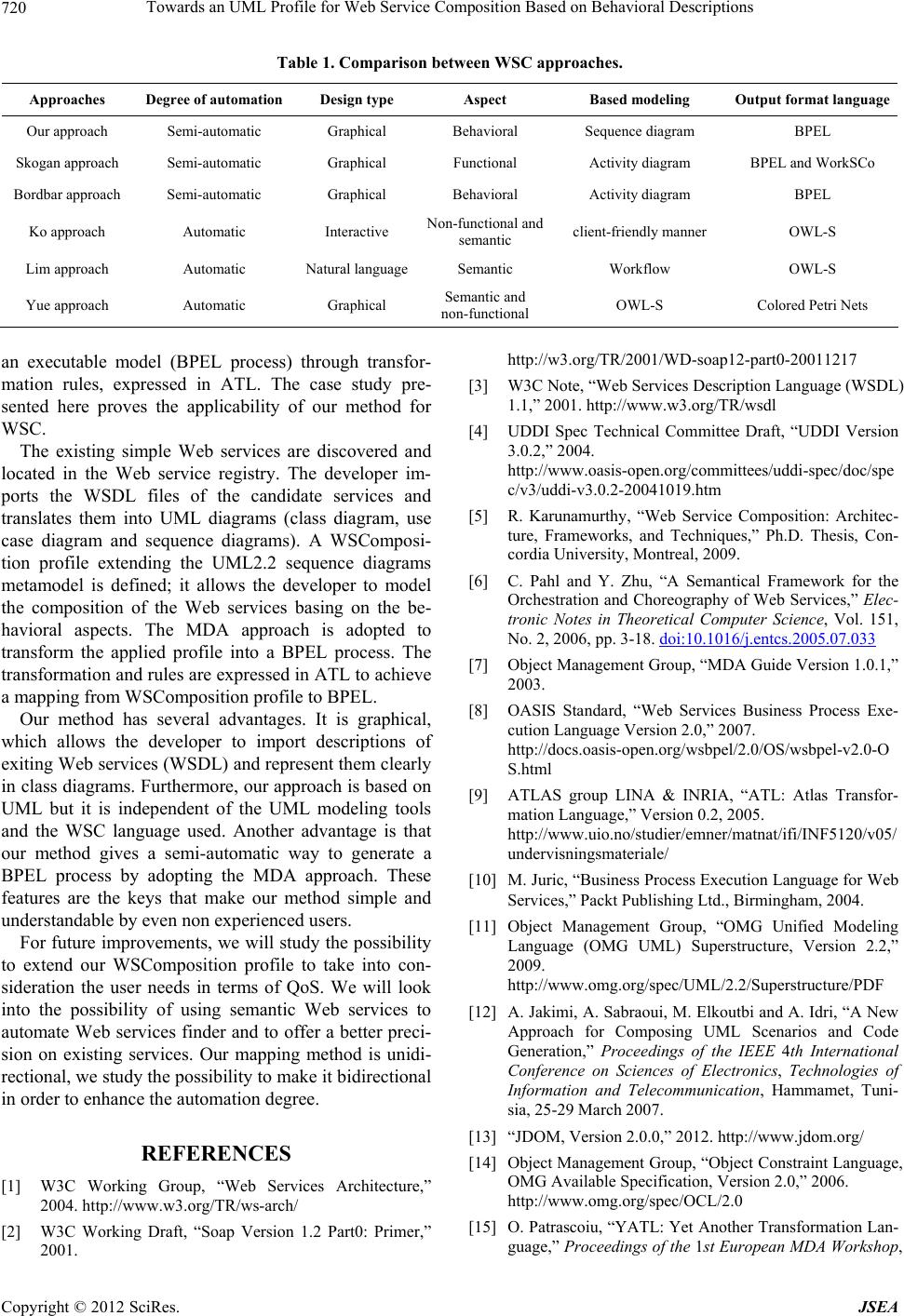 Towards an UML Profile for Web Service Composition Based on Behavioral Descriptions 720 Table 1. Comparison between WSC approaches. Approaches Degree of automation Design type Aspect Based modeling Output format language Our approach Semi-automatic Graphical Behavioral Sequence diagram BPEL Skogan approach Semi-automatic Graphical Functional Activity diagram BPEL and WorkSCo Bordbar approach Semi-automatic Graphical Behavioral Activity diagram BPEL Ko approach Automatic Interactive Non-functional and semantic client-friendly manner OWL-S Lim approach Automatic Natural languageSemantic Workflow OWL-S Yue approach Automatic Graphical Semantic and non-functional OWL-S Colored Petri Nets an executable model (BPEL process) through transfor- mation rules, expressed in ATL. The case study pre- sented here proves the applicability of our method for WSC. The existing simple Web services are discovered and located in the Web service registry. The developer im- ports the WSDL files of the candidate services and translates them into UML diagrams (class diagram, use case diagram and sequence diagrams). A WSComposi- tion profile extending the UML2.2 sequence diagrams metamodel is defined; it allows the developer to model the composition of the Web services basing on the be- havioral aspects. The MDA approach is adopted to transform the applied profile into a BPEL process. The transformation and rules are expressed in ATL to achieve a mapping from WSComposition profile to BPEL. Our method has several advantages. It is graphical, which allows the developer to import descriptions of exiting Web services (WSDL) and represent them clearly in class diagrams. Furthermore, our approach is based on UML but it is independent of the UML modeling tools and the WSC language used. Another advantage is that our method gives a semi-automatic way to generate a BPEL process by adopting the MDA approach. These features are the keys that make our method simple and understandable by even non experienced users. For future improvements, we will study the possibility to extend our WSComposition profile to take into con- sideration the user needs in terms of QoS. We will look into the possibility of using semantic Web services to automate Web services finder and to offer a better preci- sion on existing services. Our mapping method is unidi- rectional, we study the possibility to make it bidirectional in order to enhance the automation degree. REFERENCES [1] W3C Working Group, “Web Services Architecture,” 2004. http://www.w3.org/TR/ws-arch/ [2] W3C Working Draft, “Soap Version 1.2 Part0: Primer,” 2001. http://w3.org/TR/2001/WD-soap12-part0-20011217 [3] W3C Note, “Web Services Description Language (WSDL) 1.1,” 2001. http://www.w3.org/TR/wsdl [4] UDDI Spec Technical Committee Draft, “UDDI Version 3.0.2,” 2004. http://www.oasis-open.org/committees/uddi-spec/doc/spe c/v3/uddi-v3.0.2-20041019.htm [5] R. Karunamurthy, “Web Service Composition: Architec- ture, Frameworks, and Techniques,” Ph.D. Thesis, Con- cordia University, Montreal, 2009. [6] C. Pahl and Y. Zhu, “A Semantical Framework for the Orchestration and Choreography of Web Services,” Elec- tronic Notes in Theoretical Computer Science, Vol. 151, No. 2, 2006, pp. 3-18. doi:10.1016/j.entcs.2005.07.033 [7] Object Management Group, “MDA Guide Version 1.0.1,” 2003. [8] OASIS Standard, “Web Services Business Process Exe- cution Language Version 2.0,” 2007. http://docs.oasis-open.org/wsbpel/2.0/OS/wsbpel-v2.0-O S.html [9] ATLAS group LINA & INRIA, “ATL: Atlas Transfor- mation Language,” Version 0.2, 2005. http://www.uio.no/studier/emner/matnat/ifi/INF5120/v05/ undervisningsmateriale/ [10] M. Juric, “Business Process Execution Language for Web Services,” Packt Publishing Ltd., Birmingham, 2004. [11] Object Management Group, “OMG Unified Modeling Language (OMG UML) Superstructure, Version 2.2,” 2009. http://www.omg.org/spec/UML/2.2/Superstructure/PDF [12] A. Jakimi, A. Sabraoui, M. Elkoutbi and A. Idri, “A New Approach for Composing UML Scenarios and Code Generation,” Proceedings of the IEEE 4th International Conference on Sciences of Electronics, Technologies of Information and Telecommunication, Hammamet, Tuni- sia, 25-29 March 2007. [13] “JDOM, Version 2.0.0,” 2012. http://www.jdom.org/ [14] Object Management Group, “Object Constraint Language, OMG Available Specification, Version 2.0,” 2006. http://www.omg.org/spec/OCL/2.0 [15] O. Patrascoiu, “YATL: Yet Another Transformation Lan- guage,” Proceedings of the 1st European MDA Workshop, Copyright © 2012 SciRes. JSEA 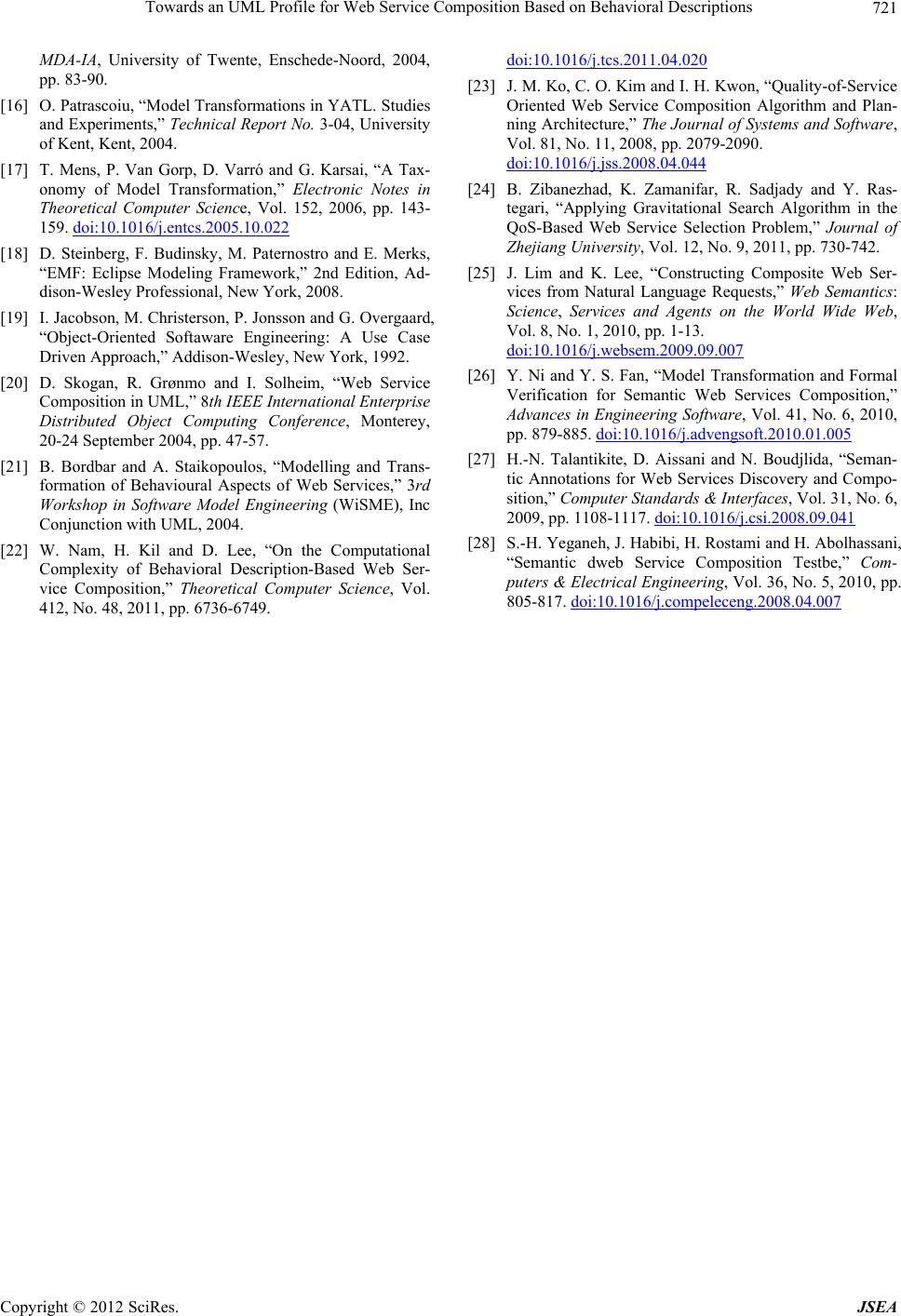 Towards an UML Profile for Web Service Composition Based on Behavioral Descriptions 721 MDA-IA, University of Twente, Enschede-Noord, 2004, pp. 83-90. [16] O. Patrascoiu, “Model Transformations in YATL. Studies and Experiments,” Technical Report No. 3-04, University of Kent, Kent, 2004. [17] T. Mens, P. Van Gorp, D. Varró and G. Karsai, “A Tax- onomy of Model Transformation,” Electronic Notes in Theoretical Computer Science, Vol. 152, 2006, pp. 143- 159. doi:10.1016/j.entcs.2005.10.022 [18] D. Steinberg, F. Budinsky, M. Paternostro and E. Merks, “EMF: Eclipse Modeling Framework,” 2nd Edition, Ad- dison-Wesley Professional, New York, 2008. [19] I. Jacobson, M. Christerson, P. Jonsson and G. Overgaard, “Object-Oriented Softaware Engineering: A Use Case Driven Approach,” Addison-Wesley, New York, 1992. [20] D. Skogan, R. Grønmo and I. Solheim, “Web Service Composition in UML,” 8th IEEE International Enterprise Distributed Object Computing Conference, Monterey, 20-24 September 2004, pp. 47-57. [21] B. Bordbar and A. Staikopoulos, “Modelling and Trans- formation of Behavioural Aspects of Web Services,” 3rd Workshop in Software Model Engineering (WiSME), Inc Conjunction with UML, 2004. [22] W. Nam, H. Kil and D. Lee, “On the Computational Complexity of Behavioral Description-Based Web Ser- vice Composition,” Theoretical Computer Science, Vol. 412, No. 48, 2011, pp. 6736-6749. doi:10.1016/j.tcs.2011.04.020 [23] J. M. Ko, C. O. Kim and I. H. Kwon, “Quality-of-Service Oriented Web Service Composition Algorithm and Plan- ning Architecture,” The Journal of Systems and Software, Vol. 81, No. 11, 2008, pp. 2079-2090. doi:10.1016/j.jss.2008.04.044 [24] B. Zibanezhad, K. Zamanifar, R. Sadjady and Y. Ras- tegari, “Applying Gravitational Search Algorithm in the QoS-Based Web Service Selection Problem,” Journal of Zhejiang University, Vol. 12, No. 9, 2011, pp. 730-742. [25] J. Lim and K. Lee, “Constructing Composite Web Ser- vices from Natural Language Requests,” Web Semantics: Science, Services and Agents on the World Wide Web, Vol. 8, No. 1, 2010, pp. 1-13. doi:10.1016/j.websem.2009.09.007 [26] Y. Ni and Y. S. Fan, “Model Transformation and Formal Verification for Semantic Web Services Composition,” Advances in Engineering Software, Vol. 41, No. 6, 2010, pp. 879-885. doi:10.1016/j.advengsoft.2010.01.005 [27] H.-N. Talantikite, D. Aissani and N. Boudjlida, “Seman- tic Annotations for Web Services Discovery and Compo- sition,” Computer Standards & Interfaces, Vol. 31, No. 6, 2009, pp. 1108-1117. doi:10.1016/j.csi.2008.09.041 [28] S.-H. Yeganeh, J. Habibi, H. Rostami and H. Abolhassani, “Semantic dweb Service Composition Testbe,” Com- puters & Electrical Engineering, Vol. 36, No. 5, 2010, pp. 805-817. doi:10.1016/j.compeleceng.2008.04.007 Copyright © 2012 SciRes. JSEA
|